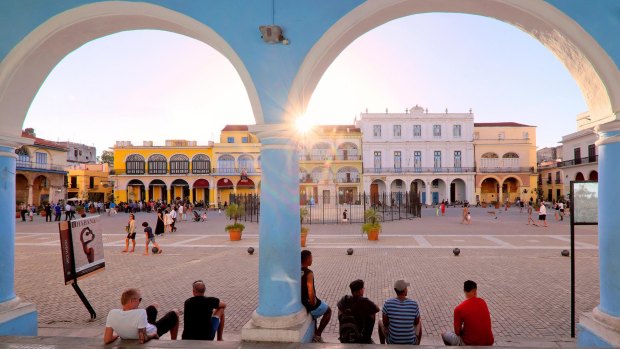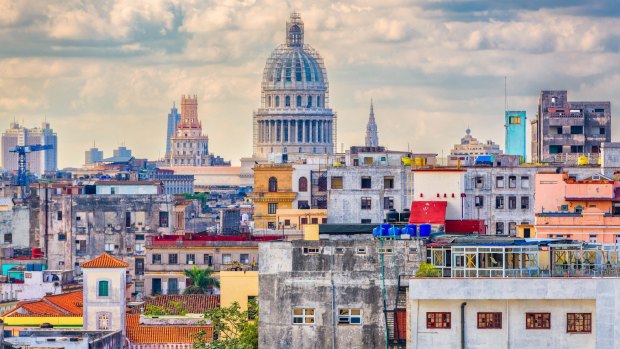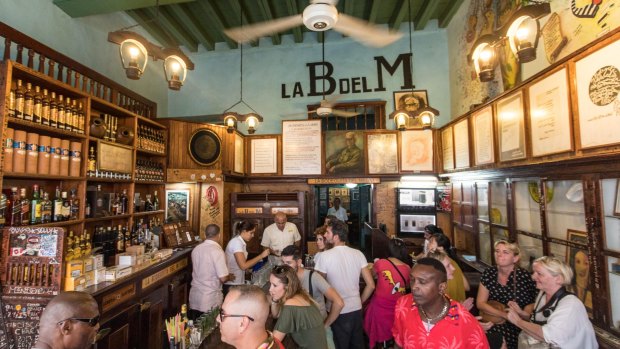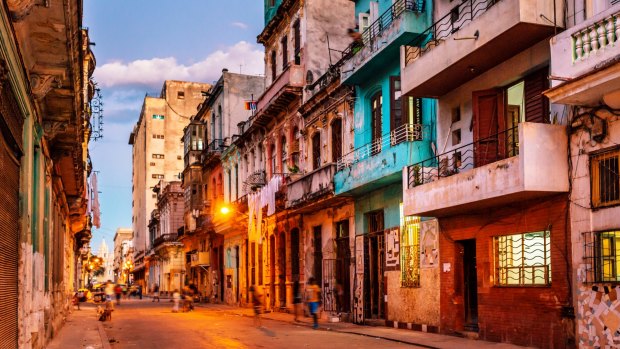This was published 4 years ago
Cuba's Havana celebrates its 500th birthday: Travel tips and a guide to visiting
By Michael Visontay

Sun setting over the colourful colonial buildings on Plaza Vieja / Old Square, Havana.Credit: Alamy
Days before we arrive in Havana, a friend is raving about the music. "On the streets, in bars, clubs, hotels… it's everywhere," she gushes, and on our first night, I'm raring to go. The hotel concierge knows of a Buena Vista club hidden down a dingy street with more cats than people outside. Up the stairs, we're in a different world: a 15-piece Afro-Cuban band and suave vocalist have a room of boisterous South Americans in seventh heaven.
The next night, we're walking along Calle Obispo, one of the city's iconic arteries, when a five-piece combo starts up in a tiny bar. People gather to dance on the street. In a flash, so are we.
My friend is right. You can't walk far in Havana, day or night, without hearing the infectious sounds of salsa and the joy of people swaying to the rhythm. I want to bottle this, yet a nagging voice in my head asks if it's all just a show.

Downtown's skyline. Credit: Alamy
"Is all this music put on for tourists?" I ask our guide Ari. "Not at all. This is who we are," he smiles. "Salsa is Cuba's gift to the world." Ari trained as an engineer, he has been to Europe and the US, but returned to live in Cuba. Ari is a patriot.
It's a good time to be back. This year Havana celebrates its 500th anniversary and the city, like Rip Van Winkle, is waking from a long slumber. Although hardly anyone takes credit cards and Wi-Fi is a waste of time, new hotels, designer stores and restaurants are jostling with the faded glory of bygone days.
As the government dips its toe into capitalism, however, the people are proud of their communist legacy. Ari regales us with the achievements of Castro's revolution – free education and healthcare, a high demand for Cuban doctors overseas, and even Havana's great European buildings. The domed white capitol building on the city's main thoroughfare, the Paseo de Marti, is modelled on the original in Washington DC, and is undergoing a lavish restoration ahead of the anniversary later this year.

La Bodeguita Del Medio, a famous bar in Old Havana.Credit: Alamy
We get a terrific view of the capitol on our tour of the Grand Theatre of Havana across the road. Now restored to its former glory, the theatre is a jaw-dropper, a soaring space of rich red seating and curtains, and compares favourably with similar icons in Buenos Aires and Naples. A few years ago, the theatre was renamed in honour of Cuba's most famous dancer, Alicia Alonso, who performed all over the world despite partial blindness from the age of 19. Alonso is still alive today, aged 98, and a beautiful statue of her adorns the foyer.
SHABBY CHIC
Ari may be proud but he is not blind to the problems on the city streets. Most buildings are peeling like sunburnt skin, their exteriors blackened and crumbling from decades of neglect and lack of money. The government has a comprehensive plan to restore the major buildings – government offices, theatres, churches – but they can't all be done at once. There's just not enough money in the kitty, so choices have to be made.

The streets of Havana at dusk.Credit: iStock
You can see what he means about priorities at the Bar Floridita just off Parque Central. Renowned as Ernest Hemingway's favoured watering hole, this 200-year-old landmark is painted in a distinctive "shabby chic" pastel rouge exterior. Tourists flock here to order daiquiris from waiters in white coats while a trio belts out Cuban standards in the corner. It's a glorious cliche but I am addicted, and the exuberance lingers long after you leave.
So does the sight that greets you outside. Right behind Floridita stands a crumbling four-storey apartment block, colonnaded on one side and open to the elements on another. It looks like a scene from Syria. The buildings around here appear derelict but people are living in them, in very meagre circumstances.
The locals bear the brunt of inadequate infrastructure in other ways. Trucks with large tanks rumble along the streets every morning to deliver drinking water to designated drop-off points; people bringing their containers out must negotiate deeply rutted footpaths and some have potholes so deep they are being used as de facto rubbish bins.
For the city's 500th anniversary celebrations, the government has earmarked more than 1000 buildings and sites to be repaired. The centrepiece is the restoration of the Capitol, for which Russia is donating a gold leaf skin to wrap around the dome. Ari rolls his eyes at this decadence; he prefers the Japanese government's gift: 100 rubbish trucks to help clean up the rubbish.
FIDEL, CHE AND THOSE CUBANS
This contrast between faded glory and decay, high culture and pop, imbues Havana with an irresistible allure. Every second shop has photos of Fidel and Che in their 1960s fatigues, bursting with military charisma. Especially Che. Like Elvis, it's as if he never died. It's enough to make you want to buy a T-shirt.
And what is Che doing in most of these photos? Is he fighting? Is he galvanising a crowd? No, he's chomping on a cigar – two Cuban icons for the price of one. The smell of cigars seems so normal here that I am almost tempted to try one (you don't inhale). But the urge quickly disappears when Ari takes us into a cigar tasting at the Conde de Villanueva Hotel on Calle Mercaderes down near the port. There we see 20 young men and women in a courtyard, puffing on a new scent of cigar. It's a scene I won't see anywhere else, and it's intoxicating, literally. After two minutes, I can't breathe properly and head outside for fresh air.
Although Che is a magnet, nothing catches the eye like Havana's army of 1950s American cars. These brightly coloured "Coches Americanos" cruise around the city, tempting tourists to jump in for a ride where they can look like rich Americans and overdose on selfies.
Why are there so many of them? When Castro assumed power in 1959, he placed a ban on foreign vehicle imports, which made it almost impossible to buy a new foreign-made vehicle. When the engines broke down, the locals used Japanese or whatever spare parts they could scramble. Although the cars look fabulous, they remain products of the 1950s. Ours has air-con, of sorts, but the rear suspension has the flexibility of concrete and if you happen to drive out on to the highways, the engine starts shuddering once you hit 90km/h.
Still, they are an efficient and enjoyable way to get around. Beyond the city centre lies New Havana, with its own tree-lined Fifth Avenue, home of the most beautiful homes and apartments. This 1960s development provides a strong contrast with the colonial architecture of the city centre. Standing out against the low-rise skyline is a concrete monstrosity that looks like a lego robot, but is in fact the Russian Embassy. Google it to see just how ugly.
THE VIEW FROM THE TOP
Street level gives you a close-up view of everyday life but to capture the scale and grandeur of Havana, you have to go up – to the rooftops of the city's iconic hotels. Our hotel, the Saratoga, opposite the Capitol, is a grand old landmark that embodies 1930s wealth and elegance; five minutes away, the brand-new Gran Manzana Kempinski is an ode to luxury and bling. Both boast rooftop pools and restaurants with stunning vistas of the city. From the Kempinski you can look across at the Bacardi building, an art deco gem that was the company's original head office in 1930.
Up here, the sky is dotted with cranes and construction sites as Fidel's brother Raul embarks on a frenzy of five-star hotels to attract foreign visitors and currency. There's reform at the other end of the property market, too. Last year the government completed its slow journey to recognising private property by law, allowing locals to buy and sell their homes.
Many Havana residents now have an incentive to renovate and are renting out rooms in their homes to generate extra income. A surprising number of tourists are trying this option in the name of an authentic Havana experience. The prices might be low but, as Ari reminds us, at least they are paying to stay in the city, putting much-needed currency in the hands of Cubans.
The locals are well disposed to visitors, and not just for the dollars. They see tourists, particularly American ones, as supporting them against Trump's hostility, which is winding back the goodwill generated by Obama's normalising of relations and hugely popular visit in 2016.
Tourist numbers are going south thanks to US policies, Ari tells us, which is the last thing Cuba needs as its government looks to tourism as the potential saviour of an economy that remains depressed. In May, the US dealt another setback by banning American cruise ships from docking in Cuba, in an effort to pressure the government to stop its support of Nicolas Maduro in Venezuela.
Little surprise, then, that whatever Trump is for, Cubans are against. Despite the dire situation in that country – no medicine, or toilet paper, let alone food and jobs – they care more about Maduro's defiance of the US than the economic misery he has inflicted on his people.
COLD WAR CHARISMA
When it comes to communist credentials, few can hold a candle to Cuba. Every guide book will point you to the Museum of the Revolution, which is housed in what used to be the Presidential Palace before 1959. Although it boasts an impressive entryway that exhibits numerous bullet holes when it was stormed by protesters, overall the museum tells a predictably one-eyed story of heroics by Fidel, Che and their comrades. The curation and exhibit translations are patchy at best.
However, next door the National Museum of Fine Arts demonstrates how Latins can breathe life into communism, expressing a vibrancy that has been squeezed out of Soviet-bloc stodge. It is well worth a few hours in the middle of a steaming hot day.
For those who are determined to get a Cold War fix, head for the Hotel Nacional, a 1930s art deco institution which was designed to lure America's rich and famous to Havana (think of Mafia boss Meyer Lansky and the Godfather 2). Built on a headland a 30-minute walk from the city centre, the Nacional is the grand dame of all Havana's great hotels.
During the Bay of Pigs crisis in 1962, Fidel Castro constructed a bunker underneath the Nacional's gardens, which has now been turned into a museum of sorts. Here you can revel in old military photos, flickering light bulbs and a maze of tunnels that sheltered volunteers who intended to fight against a US Marine assault.
When you've finished with the tunnels, head above ground to hotel foyer, which boasts an honour board of celebrities who have eaten there, and their food choices. Jean-Paul Sartre chose cheesecake, Marlon Brando tried filet mignon with french fries, Gabriel Garcia Marquez ordered banana tortilla. The Nacional also hosts a Parisien-style cabaret straight out of the nightclubs of Montmartre, with lurid Carmen Miranda outfits and Ziegfield follies razzamatazz. Very touristy but great fun.
At the end of a long day in the humid heat, take a leisurely sunset walk along the Malecon, Havana's seaside corniche, all the way round to the Nacional. It only takes about 30 minutes. Wander through the foyer, order a cocktail, take a seat near the water and enjoy what Castro missed when he stayed underground.
FIVE PLACES IN HAVANA MADE FAMOUS BY ERNEST HEMINGWAY
EL FLORIDITA
Just off the Parque Central, this 200-year-old landmark on Calle Obispo was the writer's favourite watering. Sip a daiquiri while listening to a band playing Cuban standards and look for the photo of the novelist and Fidel Castro shaking hands in the corner.
AMBOS MUNDOS HOTEL
Down the street from Floridita is the pink Ambos Mundos Hotel, where Hemingway regularly stayed in room 511. It was here that he finished Death in the Afternoon (1932) and started To Have and Have Not (1937). From this room he could see the port where his boat, the Pilar, was docked, and check on the arrival of the trade winds brought perfect conditions for marlin fishing.
LA BODEGUITA DEL MEDIO
Birthplace of Cuba's classic run cocktail the mojito, La Bodeguita del Medio was patronised by several personalities including Hemingway, although he was never a regular. Look out for his framed inscription which reads "My mojito in La Bodeguita, my daiquiri in El Floridita". At the beautiful Dos Hermanos bar near the ferry terminal, a plaque confirms visits from Ernest Hemingway, as well as other notables such as Marlon Brando and Errol Flynn.
HEMINGWAY MUSEUM AT FINCA VIGIA
A short ride out of the city centre is Hemingway's house and grounds, where he lived for 20 years. Visitors are not allowed to go inside. But through the open windows you can see the trophy heads of the big game he loved hunting, and his bathroom wall which bears the pencil marks where he recorded his weight every day. The author's boat, Pilar, sits on the grounds outside.
COJIMAR
Just outside Havana is the modest fishing village of Cojimar, where Gregorio Fuentes, the fisherman who inspired The Old Man and The Sea, fished and kept his boat. The town was the first to erect a monument to Hemingway after his suicide in 1961 at the age of 61. The author left his own boat to Fuentes when he died. His novel is taught in Cuban schools, as are his other books.
FIVE MORE THINGS TO SEE IN HAVANA
FUSTERLANDIA – THE CUBAN GAUDI
Jose Fuster is known as the Cuban Gaudi, and over the past decade he has transformed the fishing town of Jaimanitas on the outskirts of Havana, with bright playful ceramics. Fuster has now decorated more than 80 houses with mosaic tiles and fabulist domes, imbuing the whole streetscape of his town, now known as Fusterlandia, with a magical, dreamlike quality, and prompting comparisons with Gaudi's Parque Guell in Barcelona. See art-havana.com/fuster
THE CIGAR TRAIL
Even for non-smokers, it's hard to resist the allure of Cuba's cigar culture. There are half a dozen cigar factories in Havana alone. The Partagas factory, founded in 1845, offers a tour of its factory (which has moved from its original location) which allows you to see how the leaves are graded, then rolled, and boxed. The old factory behind the Capitol has now been converted into a museum and shop. At the Palacio O'Farrill, you can enjoy a Maridaje ceremony: the "marriage" or traditional pairing of a Cuban cigar with Cuban coffee and Cuban rum. See habanos.com/en/marcas/partagas
THE CHE INDUSTRY
There are several museums dedicated to the life of Ernesto "Che" Guevara, Castro's chief comrade. Start with the Museo de Comandancia del Che in old Havana. Located in it Guevara's old office in Fortaleza de San Carlos de la Cabana, it tells the story of his life with pictures and a few old belongings (radios, rucksacks and guns). About 15 minutes' drive from the city is La Cabana de Che Guevara, a mausoleum set on an elevated site with great views of Havana Bay. It houses the remains of Che and 29 of his fellow combatants killed in 1967 during their attempt to spur an armed uprising in Bolivia.
THE RUM MUSEUM
At the Museo del Ron Havana Club you can learn about the history and manufacture of Cuban rum, with exhibits that recapture the old sugar plantation era (and backbreaking life endured by the workers). Tours run every 15 minutes and the end of the tour, they offer you a taste of Havana Club rum. See havanaclubmuseum.com/en
VARADERO
Although there are some lovely beaches such as Santa Maria del Mar near Havana, most tourists who want a beach resort experience head to Varadero, about two hours drive from the capital. The water is crystal clear, development is embryonic compared to American counterparts, and the daiquiris are cheap. The resort town is so popular that it even has its own airport, allowing visitors to fly in direct.
TRIP NOTES
FLY
You can fly directly to Havana from several US cities such as New York and Miami on major American airlines, as well as from nearby countries in central America, such as Mexico.
STAY
Hotel Saratoga is a five-star, Art Deco landmark, see hotel-saratoga.com
Gran Hotel Manzana Kempinski offers modern luxury. place to stay. See hotel-kempinski.com
Hotel Inglaterra and Hotel Plaza are historic hotels in the centre of old Havana, see hotel-inglaterra-cuba.com; hotel-plazacuba.com
VISAS
You need a visa, which can be bought at the airport prior to departure. At a US airport it costs US$75; the fee is lower in other countries. If you enter from the US, check US entry conditions to Cuba, as they are more restrictive than from other countries.
HEALTH
Check smartraveller.gov.au for information about vaccinations and related health issues
CURRENCY
Cuba is still mainly a cash economy and credit cards are only accepted by major international outlets such as big hotels and designer stores. Even then, they won't accept US credit cards, though Australian ones are ok. and ATMs are very rare, so you need to have plenty of cash with you.
The local currency is the CUC and its official exchange rate with US$ is 1:1 but the effective rate IS 10% less than the official rate. So it's worth taking Euros and Canadian dollars as well. Taxi drivers will exchange currency but take lots of low denomination notes.
INTERNET
Internet is patchy at best, and even major hotels have chronic dropout problems. Wi-Fi is almost non-existent outside your hotel.
ANNIVERSARY
November 16 marks the 500th anniversary of Havana's foundation under the name of Villa de San Cristóbal de La Habana
TIMELINE
1515 - Diego Velázquez de Cuéllar founds settlement
1607 – Havana becomes capital of Cuba
1702 – City walls built
1762 – Battle of Havana; British in power
1813 – El Lucero de la Habana newspaper begins publication.
1846 – Great Havana Hurricane
1899 – US military occupation begins
1901 - Construction of the Malecón esplanade begins
1930 - Hotel Nacional de Cuba opens; Rancho Boyeros Airport begins operating; Bacardi Building constructed
1959 - January, Castro's revolutionary forces take the city
1982 - Old Havana designated an UNESCO World Heritage Site
2016 - March, US president Obama visits Havana
Michael Visontay travelled at his own expense.
Sign up for the Traveller Deals newsletter
Get exclusive travel deals delivered straight to your inbox. Sign up now.